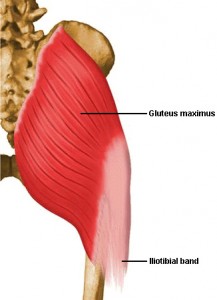 The gluteus maximus, our big butt muscle, is used and abused in every possible way.
The gluteus maximus, our big butt muscle, is used and abused in every possible way.
It is often called on to accomplish tasks outside its purview of extending the hip at the thigh.
If you stand up from a chair or come up from a squat, you are extending the thigh, which is the correct use of gluteus maximus.
Walking up an incline or a flight of stairs also engages the gluteus maximus in a way that serves us well.
What doesn’t do us a whole lot of good is engaging the gluteus maximus when it doesn’t need to be turned on. Another aspect of improper use of the gluteus maximus is engaging it too much when it should be turned out.
If you are standing well, your bones hold you up for the most part and most of your muscles are free to relax because of the positive support and weight transfer happening through your bones.
If you are standing poorly, which is almost everyone I meet, your thighs are likely forward of your hips, taking the bones out of alignment and turning on the gluteus maximus to help hold us up.
This is a major bummer for this essential muscle. This type of overuse actually affects the muscles of the pelvis underlying the gluteus maximus—piriformis, and the other two gluteal muscles, medius, and minimus.
As a yoga teacher, I teach a lot of bridge poses. A lot. They have so much to offer in terms of both strength and awareness building.
When a student goes up into bridge in a way I like the feet stay grounded to both the inner and outer foot, and the inner thighs activate to draw the thighs in and down creating space in the pelvis for the spine to extend.
The gluteus maximus working well facilitates this extending down toward the heels along with the hamstrings.
If the gluteus maximus works too much, which often happens when people lack the core tone to go up and stay up with ease, the legs are forced into external rotation, which is bad enough in bridge but when the same thing happens in wheel pose or other backbends, the sacroiliac joint and lower back are compromised.
And what fun is that?
***
